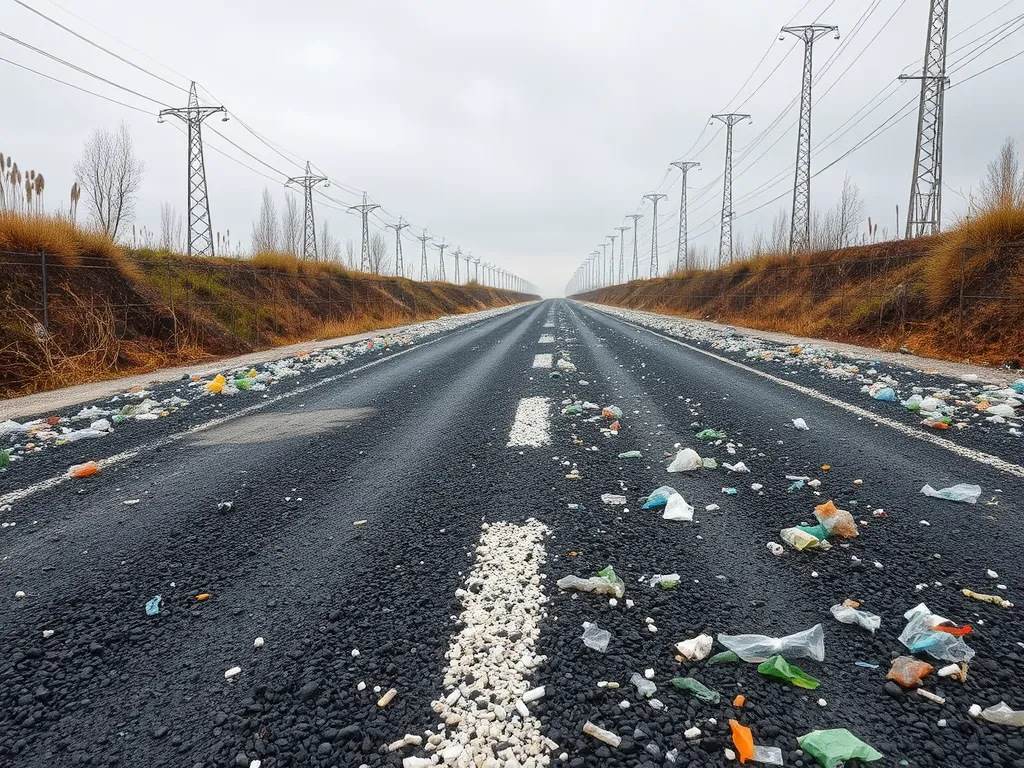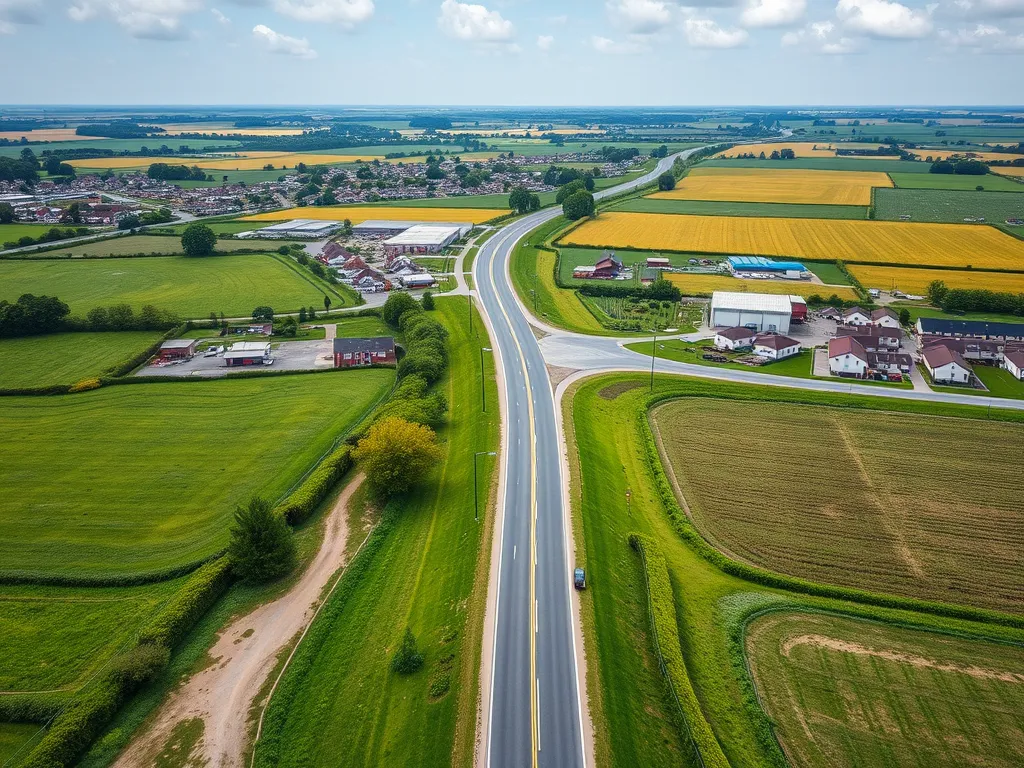How Asphalt Technology is Reshaping Emerging Economies
Published on: August 9, 2025 | Last Updated: April 14, 2025
Written By: George Voss
Asphalt technology in emerging economies combines traditional road-building materials like aggregates and bitumen with modern innovations to address urgent infrastructure needs while tackling climate challenges. Unlike developed nations, these regions prioritize cost-effective adaptations—using recycled asphalt pavement (RAP) rates up to 30% and warm-mix asphalt (WMA) that cuts production temperatures by 50°F. Rapid urbanization drives demand, with the global asphalt market projected to grow 4.2% annually through 2028. Yet hurdles persist: limited funding, extreme weather conditions, and gaps in technical training stall progress.
This article examines how emerging economies use asphalt technology to build roads, highways, and urban networks. Explore current applications like porous asphalt for flood control and polymer-modified binders for tropical climates. Learn about barriers—from machinery costs exceeding $250,000 to inconsistent material quality—and solutions like public-private partnerships. Discover sustainable practices reducing CO₂ emissions by 15-20% per project. Finally, review FAQs on market trends, recycling methods, and financing models driving this infrastructure revolution.
Contents
Introduction to Asphalt Technology
Asphalt mixes rock, sand, and sticky binder to build roads. This blend creates smooth, long-lasting surfaces. It adapts to heat, cold, and heavy loads without cracking.
Defining Asphalt Technology and Its Core Components
Asphalt combines three core parts: aggregates (crushed stone), binder (black glue), and filler. The binder, called bitumen, binds materials. New tools like PG binders (Performance Grade) rate bitumen strength for local climates. Systems like Superpave—a mix design method—optimize rock size and binder levels. These steps ensure roads last 15-20 years with minimal upkeep.
Role Of Asphalt in Emerging Economies’ Infrastructure Development
Emerging economies use asphalt to connect cities, ports, and farms. Strong roads boost trade, jobs, and access to schools. Warm-mix asphalt tech cuts paving temps by 50°F, saving fuel and costs. Recycled asphalt pavement (RAP) reuses 30-50% of old roads, slashing project costs by up to 30%. Kenya’s Thika Highway and India’s NH 19 show how asphalt tech supports rapid growth.
Next, we explore how these methods are applied in real-world projects—from city streets to rural paths.
Current Applications Of Asphalt Technology
From megacities to remote villages, asphalt technology drives infrastructure growth across emerging markets. Modern methods balance cost, durability, and environmental needs while adapting to diverse terrains.
Asphalt Paving Technology for Road Construction
Emerging economies now use warm-mix asphalt (WMA) to build roads 20% faster than traditional hot-mix methods. Countries like India and Nigeria apply polymer-modified binders (PMBs) to withstand monsoons and extreme heat above 104°F. Ghana’s 2023 Kumasi Highway Project used PG 76-22 grade asphalt to resist rutting under heavy truck loads exceeding 8,000 vehicles daily.
Asphalt Concrete Technology in Urban and Rural Infrastructure
Stone mastic asphalt (SMA) dominates urban projects for noise reduction up to 5 decibels on streets like Jakarta’s Sudirman Avenue. Rural areas opt for porous asphalt layers that drain 500 gallons of water per hour, preventing flood damage during rainy seasons. Vietnam’s Mekong Delta uses open-graded friction courses (OGFC) on 300+ miles of farm-access roads, boosting agricultural transport efficiency by 40%.
Integration Of Recycled Materials in Asphalt Pavement
Brazil recycles 80% of reclaimed asphalt pavement (RAP) in new projects, slashing material costs by 25%. Kenya’s Thika Superhighway blends 15% plastic waste into asphalt mixes, diverting 3,000 tons of landfill debris annually. Peru’s National Asphalt Technology Center developed cold recycling techniques using 50% RAP for high-altitude roads above 13,000 feet.
While these innovations reshape transportation networks, scaling them requires tackling persistent roadblocks. Next, we examine the hurdles limiting wider adoption across resource-constrained regions.

Challenges in Adopting Asphalt Technologies
New asphalt methods face roadblocks in emerging markets. Limited funds, weak systems, and gaps in know-how slow progress. Let’s break down these hurdles.
Infrastructure Gaps and Resource Accessibility
Many regions lack roads to move gear and materials. Rough routes delay trucks hauling asphalt mix or recycled parts. Up to 40% of project budgets go to transport costs in areas like Sub-Saharan Africa. Power cuts shut down asphalt plants for hours. Some nations import 70% of bitumen, paying extra fees. This strains tight budgets.
Technical Expertise and Workforce Capacity Building
Local crews often lack training in new tech like warm-mix asphalt or polymer blends. Less than 1 in 5 road teams use PG-graded binders properly. Programs like Kenya’s Asphalt Tech Hub teach mix design and recycling. Thailand’s Kasetsart University runs labs for testing pavement layers. Still, rural areas face staff shortages. Skilled workers earn 3x more in cities, pulling talent from needed zones.
Financial Constraints and Investment Barriers
High startup costs block green asphalt options. A recycled road costs $85 per ton vs $60 for standard mix. Banks charge 12-18% interest on loans, twice rates in rich nations. Carbon funds help: Mexico’s EcoPave plan cut CO2 by 30% and won $20M in climate grants. But most towns can’t tap these tools. Public-private deals fill gaps – Brazil’s RoadBoost program funded 45 projects since 2021.
These hurdles shape how nations build roads. Next, we explore eco-friendly fixes that balance cost, skill, and green goals.
Also See: Chemical Composition Of Bitumen: Key Elements
Environmental Considerations in Asphalt Practices
Emerging economies face growing pressure to balance road development with ecological responsibility. Asphalt production and road construction account for 3-5% of global CO₂ emissions. New methods now prioritize greener approaches without sacrificing durability.
Sustainable Production Techniques for Asphalt Materials
Warm-mix asphalt (WMA) cuts production temperatures by 20-40°C compared to traditional hot-mix methods. Lower heat slashes fuel use by 30% and cuts fumes by up to 50%. Thailand’s Kasetsart University Asphalt Technology Center recently tested WMA with local aggregates, achieving 12% lower energy costs per kilometer.
Recycled Asphalt Pavement (RAP) reuse now reaches 40-60% in projects across Brazil and Nigeria. Blending RAP with virgin materials lowers costs by 20-30% while maintaining structural strength. Cold recycling techniques, like foamed bitumen stabilization, enable on-site reuse of old pavement for rural roads.
- Bio-based binders from palm oil or algae reduce reliance on petroleum bitumen
- Porous asphalt systems manage stormwater, reducing urban flooding risks
- Solar-powered asphalt plants cut grid dependence in remote areas
Strategies to Minimize Carbon Emissions in Road Projects
Carbon capture systems in asphalt plants now trap 70-90% of CO₂ emissions. India’s National Highways Authority mandates these systems for all new facilities by 2025. Hybrid rollers combining electric and diesel power lower fuel consumption by 45% during compaction.
Emerging economies adopt the Global Carbon Council’s emission benchmarks for road projects. Kenya’s Mombasa-Nairobi highway upgrade used low-carbon asphalt mixes, avoiding 18,000 tons of CO₂. Lifecycle assessment tools like PaLATE help planners compare emissions across material choices.
- Geosynthetic-reinforced bases cut asphalt layer thickness by 25%
- Phase change materials in pavements reduce urban heat island effects
- GPS-guided machinery optimizes material use, trimming waste by 8-12%
Balancing ecological goals with road-building demands requires adaptive strategies. Next, we examine barriers to implementing these solutions at scale.

FAQs on Asphalt Technology in Emerging Economies
What Role Does Recycling Play in Enhancing Asphalt Technology in Emerging Economies?
Recycling significantly enhances asphalt technology by allowing emerging economies to reuse materials, reducing costs and environmental impact. For example, countries like Brazil recycle up to 80% of reclaimed asphalt pavement (RAP), which not only conserves resources but also minimizes the amount of waste sent to landfills.
How is the Performance Of Asphalt Mixes Tested in Different Climate Conditions?
The performance of asphalt mixes is tested through various methods, including the use of Performance Grade (PG) binders, which are rated according to local climate conditions. This ensures that asphalt can withstand extreme weather, such as high heat or heavy rainfall, helping to extend the lifespan and durability of road surfaces.
How Can Emerging Economies Finance New Asphalt Technology Initiatives?
Financing new asphalt technology initiatives in emerging economies can involve a combination of public-private partnerships, international funding, and local government investment. Innovative financing models, such as climate grants and green bonds, can also help cover initial costs associated with adopting sustainable practices.
What Are Some Successful Examples Of Asphalt Technology Implementation in Emerging Markets?
Successful examples include Kenya’s Thika Superhighway, which incorporated recycled materials and warm-mix asphalt technology, and India’s National Highway 19 project, which employed polymer-modified binders for enhanced performance in extreme weather. These projects highlight the potential for asphalt technology to meet infrastructure demands effectively.
How Does the Adoption Of Asphalt Technology Impact Local Communities?
The adoption of asphalt technology often leads to improved road quality and accessibility, resulting in better connectivity for local communities. This can enhance trade, boost economic activities, and provide better access to education and healthcare services, thereby significantly improving the quality of life for residents.

Closing Thoughts
Asphalt technology is transforming the landscape of infrastructure in emerging economies. With its ability to enhance road quality and accessibility, it plays a vital role in economic development. The integration of modern techniques, such as recycled materials, not only contributes to sustainability but also offers cost savings essential for these growing markets.
While challenges like resource accessibility and financial constraints exist, innovative solutions are emerging. By investing in workforce training and sustainable practices, these economies can harness the full potential of asphalt technology. This progression fosters improved transportation networks, facilitating trade and movement and paving the way for a more connected future.
For more insights and resources on this topic, visit Asphalt Calculator USA.
Additional Resources for You:
- Roberts, F. L., Kandhal, P. S., Brown, E. R., Lee, D. Y., & Kennedy, T. W. (1996). Hot Mix Asphalt Materials, Mixture Design, and Construction (2nd ed.). National Asphalt Pavement Association (NAPA).
- Advances in Asphalt Materials | ScienceDirect
- New Innovations That Will Change How Asphalt Paving is Done Commercial Asphalt, Parking Lot Paving + Best in Pinellas! Anderson & Sons Asphalt of Pinellas
- Building Asphalt Market Scope, Segmentation, Key Players, Trends, & Analysis By 2029
- Innovation | Asphalt Pavement Alliance


